So, at the risk of starting one of those annoying meme's, I've kinda had this conversation with a few folks before and people of my age always seem to enjoy it so here goes. My first computers.
My First Computer
The computer I first learnt to code on was a Commodore Vic-20. My parents bought it because they saw William Shatner advertising it on the telly and suspected that these computer things might catch on one day and I should probably learn about them. We spent hours sitting and typing in code from printouts in magazines and then debugging our typing mistakes. Unlike some people, we were lucky enough to have a tape drive to save our work before we switched it off. The following year I got the 8k expansion pack which doubled my available memory. The Vic-20 was when I learned binary arithmetic because a poke instruction was needed to draw a character to the screen that was not a standard Alpha-numeric - what you were actually doing was writing directly to the 6560 Video Interface Chip after which the computer was named (VIC - geddit?). Any spare squared paper I could find was always covered with little grids with drawings in them of graphics for potential games. I still use this skill today but more often for bitwise flags than for coding space invaders. My favorite game for the Vic-20 was "Psycho Shopper" - a game who's premise escapes me but I seem to remember it had something to do with old women and walking frames.
I remember that after using the Vic-20 I happened upon a book that described the Teletext system that was going to be coming soon if you owned an expensive TV. I was amazed at the quality of the graphics when I first saw Ceefax. Later in life the Vic-20 got replaced by a Commodore Plus/4 which was a bit of a failure but allowed you to play most of the Commodore-64 games I had been very jealous of. The Commodore Plus/4 had a built in Word processor and spreadsheet and I never hand-wrote a school assignment again after we got that in 1984.
First Games Console
Before the VIC-20, we had an Atari 2600. This was early in my career as a gamer (I was probably around about 3 or 4 years old at the time) but I remember that it had the most exquisite multi-position switches and the paddle controlled "tennis" game was exquisite in it's interactivity - only recently surpassed by the Wii controllers.
First PDA
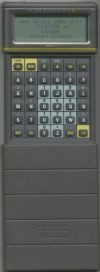 Ahh, my lovely Psion LZ (or Lizzy as us Psion fanboys used to call them). While I did use this as a PDA, the Psion was a remarkable device that had a very comprehensive programing language in OPL. Hear that Apple - a personal organizer that shipped with it's own IDE, and was designed to be coded... OPL was like BASIC and had all the constructs you needed to do some serious stuff. The Psion Organiser II's also had a very neat Database system that was easy to program which made it suitable for business use and found many vertical niches. Marks and Spencer's in the UK used to run their entire retail operation by having Psion organiser at each till and would send the "Datapaks" (physical solid state storage cartidges) of data down to their branch offices each day.
Ahh, my lovely Psion LZ (or Lizzy as us Psion fanboys used to call them). While I did use this as a PDA, the Psion was a remarkable device that had a very comprehensive programing language in OPL. Hear that Apple - a personal organizer that shipped with it's own IDE, and was designed to be coded... OPL was like BASIC and had all the constructs you needed to do some serious stuff. The Psion Organiser II's also had a very neat Database system that was easy to program which made it suitable for business use and found many vertical niches. Marks and Spencer's in the UK used to run their entire retail operation by having Psion organiser at each till and would send the "Datapaks" (physical solid state storage cartidges) of data down to their branch offices each day.
I did some serious hacking LZ (which had a massive 4 lines to work in). Again, using the binary arithmatic learnt on the Vic-20, I was able to do some nice graphics work and had several games to my credit. After the Psion LZ's came the Series 3's which I could never justify the expense. As mentioned in a post a while ago, Robert Parsons was the master of Series 3 hacking in my playground. He even managed to fake grayscale by switching the black of the LCD very rapidly (a-la early Gameboy devices). He even wrote a fractal generator, 3D graphics and the most addictive game ever (Bobman).
First Self-Built Microprocessor System (kinda)
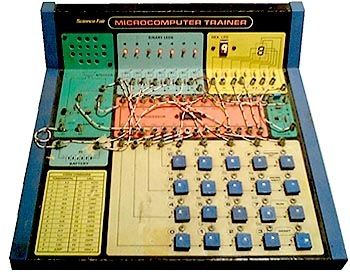 When I was 7 or 8, I went into my local Tandy's store in Arnold and spent my parents hard earned money on the Science Fair Microcomputer Trainer (based on a Texas Instruments TMS1100 CPU). I'd previously gone through nearly every X-in-1 electronics kit from that Tandy store (in fact, looking at this page I owned all of those and can still remember the particular "hot electronics combined with cardboard and metal of the springs" smell that I used to enjoy on opening the boxes. When I saw the Science Fair Microcomputer Trainer sat high on the top shelf, I was smitten. To be honest, at that age it was pretty complicated but it did teach me most of what I know now about how computers work at a low level - it was all about putting stuff onto the stack and incrementing etc. It also taught me how to wire fast and neat which I put to good use in my Electronic's GCSE.
When I was 7 or 8, I went into my local Tandy's store in Arnold and spent my parents hard earned money on the Science Fair Microcomputer Trainer (based on a Texas Instruments TMS1100 CPU). I'd previously gone through nearly every X-in-1 electronics kit from that Tandy store (in fact, looking at this page I owned all of those and can still remember the particular "hot electronics combined with cardboard and metal of the springs" smell that I used to enjoy on opening the boxes. When I saw the Science Fair Microcomputer Trainer sat high on the top shelf, I was smitten. To be honest, at that age it was pretty complicated but it did teach me most of what I know now about how computers work at a low level - it was all about putting stuff onto the stack and incrementing etc. It also taught me how to wire fast and neat which I put to good use in my Electronic's GCSE.
While I used to enjoy typing then playing the included "Rat Bashing" game - my crowning achievement was when I wrote my first "Hello World!" program. Well it said "hEll0", but still, not bad considering the display was a single numeric LED character. Internet legend has it that this devices was overclocked, making it my first overclocked computer.
First PC
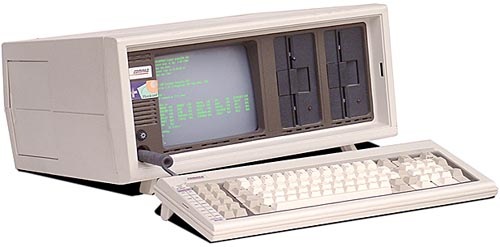 Easy - an original Compaq luggable. Also my first "laptop" I guess - but it was a little on the heavy side. I seem to remember that the reason this machine was at home was because it had a spreadsheet system (Lotus-123?). It was great because it had two 5-1/4 floppy drives so you could have your boot disc (with DOS, BASIC etc) in one and use the other for storage. Floppy disks amazed me because of the random access - previously everything else I had used was tape. I think that this was the only machine then typing "B:" took me straight to the B drive and didn't give me a prompt to insert a different disk in Drive A. I wonder - do kids today know why the hard drive on a Windows machine starts at "C"?
Easy - an original Compaq luggable. Also my first "laptop" I guess - but it was a little on the heavy side. I seem to remember that the reason this machine was at home was because it had a spreadsheet system (Lotus-123?). It was great because it had two 5-1/4 floppy drives so you could have your boot disc (with DOS, BASIC etc) in one and use the other for storage. Floppy disks amazed me because of the random access - previously everything else I had used was tape. I think that this was the only machine then typing "B:" took me straight to the B drive and didn't give me a prompt to insert a different disk in Drive A. I wonder - do kids today know why the hard drive on a Windows machine starts at "C"?
We had a copy of California games that ran on this machine (a little strange because the game was in color, but the machine's screen was a green-screen). I remember that I hacked the resource files in California games to change the annoying America phrases "That's rad dude" to more British phrases I understood. Countless hours of amusement followed when I did a good half-pipe or surf trick and got sworn at in the best anglo-saxon.
First Windows Machine
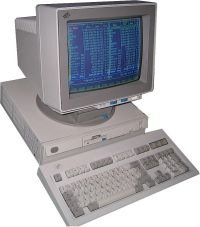 An IBM PS/2 Model 55 SX. To be fair, this belonged to my Dad's company but he used to bring it home evenings and weekends and we would set it up and I would help him do his work on it. It had an amazing 20Mb (but loud) Hard Disk (my first machine with a Hard Disk), and the IT department had coded an awesome initial menu script in the autoexec.bat of DOS when you booted it up. These start menus were all the rage at the time.
An IBM PS/2 Model 55 SX. To be fair, this belonged to my Dad's company but he used to bring it home evenings and weekends and we would set it up and I would help him do his work on it. It had an amazing 20Mb (but loud) Hard Disk (my first machine with a Hard Disk), and the IT department had coded an awesome initial menu script in the autoexec.bat of DOS when you booted it up. These start menus were all the rage at the time.
The machine originally came with Windows 2.0 which didn't really get used much. I remember the Paint program that came with 2.0 as more advanced that the version of Paint we get in Windows Vista today - it had some isometic drawing mode that was quite strange. However, it did only draw in black or white. Taking a look at some of the dialogs from back then, it is amazing how familiar some still are. Also, the DOS version of Word was pretty decent - you could draw nice boxes using the cursor keys and it would put in the appropriate "_|" characters etc. It also used bold text for bold writing unlike Wordperfect at the time. It was nearly WYSIWYG.
I still remember seeing the review of Windows 3.0 in PC World I think it was. The cover that issue was "Windows 3.0, Child's Play" and had a picture of a baby in a nappy (diaper) holding a mouse. The Microsoft Mouse 2.0 that was purchased along with that copy of Windows was a masterpiece of the mouse art, and still one of the best mice produced.
Well, that's enough trawling through memory lane. Happy Thanksgiving to all my American friends. If anyone fancies taking on this meme and detailing their computer firsts then be sure to let me know - however you are probably a lot less geeky than me and would rather keep those memories to yourself.
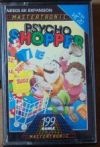
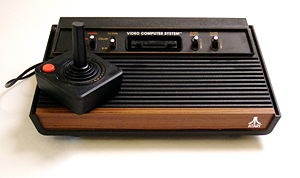

Oh yes, using every available piece of squared paper to draw game sprites!
So true...did that millions of times in my school years. Then, when I was fed up with binary math, I wrote a simple sprite editor in BASIC :)